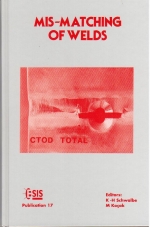Tab Article
This work contains papers presented at the International Symposium on Mis-Matching of welds organized by the GKSS-Research Centre, Geesthact. "Mis-Matching of Welds" aims to identify and highlight the significance of strength mis-match on the fracture behaviour of welded or bonded joints and interfaces. It contains fifty-three papers contributed by eminent specialists from twenty-two countries. The papers present applications of fracture mechanics testing, failure assessment, and numerical analysis aspects of mis-matched weld joints or bimaterial interfaces. It contains new, challenging and innovative studies which clearly indicated the current interest and technological need in the area of strength mis-match.


